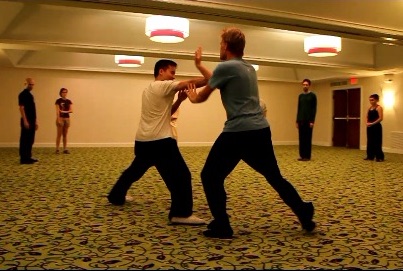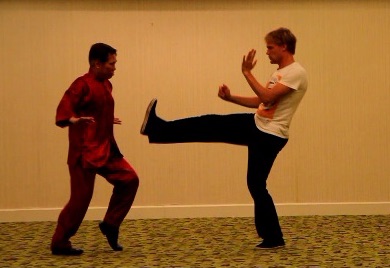SECRETS FOR TRAINING THE 13 TECHNIQUES

Ward-Off, one of the Eight Techniques
Question 5
Andrea's question reminds me of the Song of Secrets for Training the 13 Techniques.
I'm interested to know how Sifu's understanding of this classic has changed over time and how that understanding has influenced Sifu's practice, advancement and teaching of Taijiquan, as well as all types of Kung Fu. In particular I'm interested in these two lines: "All the time pay attention to your waist, the abdomen is charged with chi and might" and "What is the aim of Tai Chi Chuan practice? Health and vitality and eternal spring".
Sifu Mark Blohm
Answer
The “heart-attainments” of past masters, which may be translated as the essence of their teaching, are recorded in classics, often in what are called “kor kiut” or songs of secrets. The secrets are hidden in the open and coupled with the conciseness of the classical Chinese language and the need to have background knowledge of kungfu terms, many people may not understand the classics even when they know the dictionary meaning of all the words used in the songs of secrets.
The following “Song of Secrets for Training in the 13 Techniques”, shortened to “Songs of 13 Techniques”, is very important in Taijiquan, and has contributed much to the development of Taijiquan as well as other kungfu styles in our school. It is reproduced below first in its original Chinese wording, then in Cantonese pronunciation, in Mandarin pronunciation and in its English translation. We wish to thank Sifu Michael Chow for providing the material at "Song of Secrets for Training in the 13 Techniques".
十三勢行功歌訣
十三總勢莫輕識,命意源頭在腰隙
變轉虛實須留意,氣遍身軀不梢癡
靜中觸動動猶靜,因敵變化是神奇
勢勢存心揆用意,得來不覺費工夫
刻刻留心在腰間,腹內鬆靜氣騰然
尾閭中正神貫頂,滿身輕利頂頭懸
仔細留心向推求,屈伸開合聽自由
入門引路須口授,工用無息法自休
若言體用何為準,意氣君來骨肉臣
詳推用意終何在,益壽延年示老春
Sap Sam sai Harng Kung Kor Kiut
sap sam chong sai mok heng shik, meng yi yun tow choi yiew kwik
phin chiun hui sat sheui lau yi, hei phin kwoon keui but sau chi
cheng chong chook doong doong yau cheng, yian tik phin fa si san kei
sai sai chiun kwai yoong yi, tak lai but gau bei kung fu
hak hak lau sam choi yiew kan, fook nap soong cheng hei thang yen
mei lui choong cheng san koon deng, moon khuen heng deng tau yun
zhai sai lau sam heong chui kau, wat san hoi kap teng tzi yau
yiap moon yian lou sheui hau sau, kung yoong mou shik fatt tzi yau
ye yin thai yoong hou wai cheun, yi hei gwan lai kwat yoke san
cheong cheui yoong yi choong hou joi, yik sau yin lin si lou chiun
Shi San Shi Xing Gong Ge Jue
Shi San Zong Shi Mo Qing Shi, Ming Yi Yuan Tou Zai Yao Xi
Bian Zhuan Xu Shi Xu Liu Yi, Qi Bian Shen Qu Bu Shao Chi
Jing Zhong Chu Dong Dong You Jing, Yin Di Bian Hua Shi Shen Qi
Shi Shi Cun Xin Kui Yong Yi, De Lai Bu Jue Fei Gong Fu
Ke Ke Liu Xin Zai Yao Jian, Fu Nei Song Jing Qi Teng Ran
Wei Lu Zhong Zheng Quan Ding, Man Shen Qing Li Ding Tou Xuan
Zi Xi Liu Xin Xiang Tui Qiu, Qu Shen Kai He Ting Zi You
Ru Men Yin Lu Xu Kou Shou, Gong Yong Wu Xi Fa Zi Xiu
Ruo Yan Ti Yong He Wei Zhun, Yi Qi Jun Lai Gu Rou Chen
Xiang Tui Yong Yi Zhong He Zai, Yi Shou Yan Nian Shi Lao Chun
Song of Secrets for Training in the 13 Techniques
Don't underestimate the thirteen techniques, the source of life is at the waist
Pay attention to 'apparent' and 'solid', without hindrance chi flows with grace
Stillness in movement, movement in stillness, adjust according to what the situation is
Every technique must be guided by will, combat efficiency will be achieved with ease
All the time pay attention to your waist, the abdomen is charged with chi and might
The spine is straight and full of spirit, the whole body is relaxed with head upright
Be attentive to details in every move, spontaneous let your movements be
A teacher's guidance is needed to enter the way, when accomplished, unrestricted the rules is he
What is so difficult about the form? Mind and energy are the king
What is the aim of Tai Chi Chuan practice? Health and vitality and eternal spring
Before answering the questions posed, it would be helpful to have a brief explanation of the “Song of 13 Techniques” as follows.
The thirteen techniques refer to eight techniques and five footwork movements from which Taijiquan evolved.
The eight techniques are
- Ward off
- Roll back
- Press forward
- In contact
- Grip
- Spread
- Elbow
- Anchor
The five footwork movements are
- Move forward
- Move backward
- Move to the left
- Move to the right
- Remain at the centre
The source of Taijiquan movements is at the waist. For example, when a Taijiquan practitioner wards off an attack, he does not merely moves his hands from his elbow, but he starts his movement by rotating his waist.
In Taijiquan combat it is important to note whether an opponent’s movement is apparent, which means feint, or solid, which means real. He may, for example, feint a top movement with his hand, and when you attempt to response to this hand movement, he may kick you below, which is his real attack. However, if you neglect the feint movement, it may change to be a real attack.
This distinguishing of whether opponents’ movements are feint or real should not interrupt your chi flow and fluid bodily movement. On the other hand, when you make feint and real movements, the movements must also be smooth, and not staccato, so that your opponents may not differentiate them.
You should attain the harmony of stillness and movement. For example, when you move about vigorously, your mind is still. When you mind is active, you are relaxed and composed. You are able to adjust quickly and spontaneously to whatever the situation is. When an opponent rushes at you with multiple attacks, you remain relaxed and response accordingly. If your opponent remains still, you may make feint movements to distract him.
Every movement you make is purposeful. You do not make unnecessary or wasteful movements. In this way you attain combat efficiency easily.
All your movements issue from your waist. Your chi is always powerful and focused at your dan tian. You have good posture and good balance and presence of mind. Your whole body is relaxed and always ready for action. Your movements are spontaneous, and perfect in details.
A competent teacher is necessary to initiate you into genuine Taijiquan. At the beginning rules and guidelines speed up your progress. But when you are advanced, you would not be restricted by rules.
Although perfect form is important, you should not be unduly worried over the form. Mind and energy are the most important in Taijiquan. What is the aim of practicing Taijiuan? It is to attain good health, vitality and longevity.
An understanding of the “Song of 13 Techniques” has contributed much to both my practice and teaching of Taijiquan and all other kungfu styles. The changes brought about by this understanding may be viewed from two dimensions: before understanding this classic, and how the changes continue to improve my practice and teaching after understanding the classic.
Before my understanding of the classic, my performance of kungfu was more external and head-on when responding to opponents’ attacks. An excellent example is my changing of “Beauty Looks at Mirror” to “Single Tiger Emerges from Cave” when responding to an opponent’s thrust punch in the basic Shaolin combat sequences.
In my early years of teaching, I taught students to use “Beauty Looks at Mirror” to defend against an opponent’s “Black Tiger Steals Heart”. Later I taught students to use “Single Tiger Emerges from Cave”. Despite their names, the “Tiger” defence is “softer” than the “Beauty” defence.
This change was not influenced by any specific line in the “Song of 13 Techniques”, but by the general concept in Taijiquan of “using minimum force against maximum strength”. This concept was also applied in the Mirror Hand defence, but more so in Single Tiger.
After the understanding of the classic, changes continued to improve both my own performance and my teaching.
The line, “the source of life is at the waist”, for example is seminal. It helped to illustrate the essence of Taijiquan mechanics, leading me to understanding that even without internal force, Taijiquan could be used by a smaller-sized person against a physically stronger and bigger opponent.
The benefit was not only in defence. It was also in attack. The rotation of the waist led me to understand spiral force, and how to explode it in Single Whip. It also led me to understand exploding spiral force using Black Tiger Steals Heart in Shaolin Kungfu.
The next advancement was in reducing big movements to smaller ones. which participants at my Intensive Taijiquan Courses would have experienced, and which resulted in increasing speed and combat efficiency. A further development was exploding force from the wrist instead of from the dan tian. All these developments could be traced to the line “the source of life is at the waist” from the Song of 13 Techniques.
The line “without hindrance chi flows with grace” was also very influential. Before understanding this line, my Taijiquan movements were graceful but still physical. After understanding it, I was able to generate energy flow, then internal force with my Taijiquan practice.
The benefit spilled over to other styles of kungfu. My Shaolin Kungfu became smooth and flowing. Some of those who attended my Intensive Shaolin Kungfu Course would have remember me telling them to perform Shaolin Kungfu movements as if they were Taijiquan.
In Wuzuquan it enhanced the development of internal force in San Zhan, a skill I took more than two years to acquire in the late 1960s, but which with the help of chi flow course participants at the Special Wuzuquan Course in Penang in December 2012 could acquire in a matter of days!
In the Baguazhang Course in June 2012, chi flow not only helped course participants to develop internal force using the eight mother palms but also move fast and effortlessly in Baguazhang Circle Walking. It even enhanced consolidation of internal force in such a powerful set as Iron Wire.
These developments in Taijiquan as well as other kungfu styles owed much to the line "All the time pay attention to your waist, the abdomen is charged with chi and might" of the Song of 13 Techniques. Paying attention to waist rotation not only has made all our kungfu movements very elegant, and enabled us to exploit the momentum of our opponents, but also has remarkably enhanced our generating and exploding spiral force.
The line “What is the aim of Tai Chi Chuan practice? Health and vitality and eternal spring" has helped to shape the basic philosophy of our school regarding why we train kungfu and chi kung. While students of many other kungfu schools hurt themselves physically and psychologically in their free sparring practice, and students of many other chi kung schools focus on learning and demonstrating chi kung techniques, we are very clear that the priority of our kungfu and chi kung training is to have good health, vitality and longevity.

Remain at Centre, of the Five Movements
The questions and answers are reproduced from the thread Wahnam Cloud Hands Grasp Sparrow Set: 10 Questions to Grandmaster Wong in the Shaolin Wahnam Discussion Forum.
LINKS
